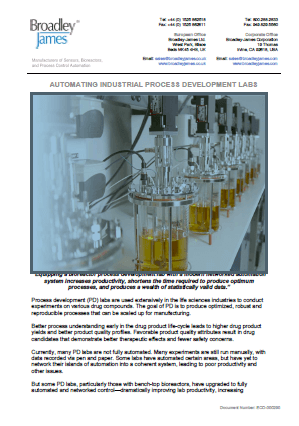For pharmaceutical and biotech manufacturers, the process of drug compound experimentation requires robust and reproducible results before the scale up process can begin.
 Emerson’s Chris Amstutz pointed me to a great whitepaper by Broadley James, Automating Industrial Process Development Labs. It highlighted their work with pharmaceutical manufacturers but generalized the areas of opportunity to create value in bioreactor process development (PD) labs. Their BioNet bioreactor control system embeds a DeltaV system.
Emerson’s Chris Amstutz pointed me to a great whitepaper by Broadley James, Automating Industrial Process Development Labs. It highlighted their work with pharmaceutical manufacturers but generalized the areas of opportunity to create value in bioreactor process development (PD) labs. Their BioNet bioreactor control system embeds a DeltaV system.
Within the Life Sciences industry, these labs are used to conduct experiments on drug compounds. These experiments have traditionally been done manually given their small scale. The process is manual not only in physical adjustments to the running experiments, but also in recording data with pen and paper. In other cases, some processes are automated but isolated from one another.
Upgrading to fully automated, networked-based control helps to increase the number of experiments performed, reduce labor and equipment resource requirements, and automate the data collection process. The whitepaper enumerates 10 potential improvements:
- More experiments started and successfully completed
- All experiments run under statistically similar conditions
- More and better data collected
- Greater statistical validity
- Experiments can be monitored remotely
- Labor productivity increases several-fold
- Improved tech transfer for production scale-up
- Improved relationships with CMOs and regulatory agencies
- Enables integration of widely dispersed facilities
- Significant cost savings and superior ROI
It goes on to describe many of these areas in more detail. For example, more experiments are possible because:
…the process parameters and advanced control strategies for each experiment are stored in the automation system in a template, instead of being manually created, often from scratch. Prior run templates can be easily modified, quickly leading to a new experiment and corresponding data. Each run template can be automatically assigned to any number of bioreactor vessels on any bench in a lab.
Without a networked automation system, it’s often necessary for data to be manually entered at each vessel. A 24-vessel run would thus require 24 manual data entry sessions, a time consuming process fraught with possibilities for error.
Automatic control also provides greater consistency than is possible with manual control. Beyond classic PID control, the whitepaper’s author notes the use of [hyperlink added]:
…more advanced loop control methodologies such as model-based control. Superior process control means that experiment parameters are controlled closer to setpoint, resulting in better data resolution and confidence levels, while yielding greater experimental success and improved process understanding.
In process development labs, the data associated with the batches is as critical as the running process. This data comes from the bioreactor automation system on measurements such as temperature, pressure, pH, dissolved oxygen, and volume of gasses plus:
…all manually entered information such as batch times, run parameter templates, and various control strategies.
Another type of “at-line” data collected comes from online samplers and analyzers, and offline laboratory measurements looking at parameters such as protein content.
Having this data together helps the analysis process to determine optimum conditions for the batch process. When this optimum point is reached:
…multiple experiments can be quickly run with this condition to generate statistically valid data, crucial for tech transfer.
Once reserved only for scaled up batch processes, the technology is now available at the process development lab phase. Check out the whitepaper if part of your responsibilities includes the process development lab or technology transfer phases of the life cycle.
Also, if you’ll be joining us at this year’s October 8-12th Emerson Exchange in Anaheim, Chris shared this workshop you’ll want to catch, Session: 4-1481 – Implementing Pfizer’s BioNet DeltaV Bioreactor Control System.




